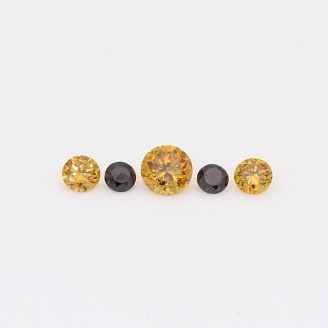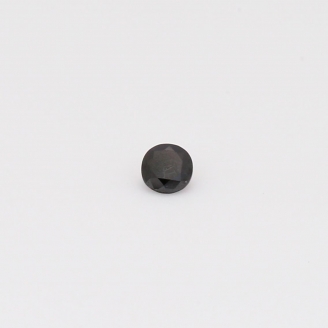Loose Black Diamonds
Shop our collection of loose black diamonds, including matched black diamond pairs, ideal for crafting custom jewellery pieces that make a bold impression!
Whether you're envisioning a pair of striking black diamond earrings or seeking a singular, unforgettable black diamond engagement ring, our selection offers the perfect canvas for your creativity. Book a jewellery design consultation with our coloured diamond experts today.
Buy Loose Black Diamonds from Nina's Jewellery
Black diamonds are the latest addition to Nina's collection of high-quality loose coloured diamonds.
What are black diamonds?
Black diamonds are opaque diamonds that get their distinctive colour from inclusions of graphite, pyrite, or other minerals within the diamond's structure. These inclusions block light from passing through the stone, giving it a dark, almost metallic appearance.
Black diamonds are also called ‘carbonados’, a Portuguese term roughly translated to ‘carbon-like’ or ‘black like coal’. It was given this name by Portuguese prospectors who discovered black diamonds in Brazil in the 1840s because they thought they resembled charcoal.
Black diamonds share some chemical and physical traits with lab-grown diamonds (via chemical vapour deposition) and type Ib diamonds rich in hydrogen. But carbonados have unique pores and coatings, different isotope patterns, and a lack of minerals typically found in the Earth's mantle. On top of that, it contains unusual metal inclusions, making it one of the most intriguing and unique diamond types ever discovered.
Are black diamonds natural?
Yes, black diamonds can be natural, but they are extremely rare and found mostly in Brazil and the Central African Republic.
There are also treated or enhanced black diamonds made in laboratories.
All black diamonds at Nina’s Jewellery are natural stones, but in order to be suitable for setting in jewellery, have been heat treated for strength and colour consistency.
How are black diamonds made?
The origin of natural black diamonds remains a mystery, with some believing they could have formed in the intense pressure and heat of supernovae explosions, later arriving on Earth aboard meteorites millions of years ago. This would explain their presence in areas devoid of other diamond deposits, their unusual structure and their unique composition and porosity.
Another theory is that black diamonds are forged deep within the Earth's mantle, under immense pressure and scorching heat. They make their way to the surface–often found in alluvial deposits, such as riverbeds–after being eroded from their original volcanic source.
Unlike their natural counterparts, Treated black diamonds are created through a process that alters the colour of ordinary colourless diamonds. The most common methods are High Pressure-High Temperature (HPHT) treatment and irradation.
With HPHT, colourless diamonds are subjected to extreme pressures and temperatures in a controlled environment. This treatment alters the diamond's internal structure, creating microscopic fractures and voids that trap light, resulting in a dark, almost black appearance.
Irradiation involves exposing colourless diamonds to high-energy radiation (like neutron bombardment). Radiation disrupts the diamond's atomic structure, creating colour centres and altering its light absorption, leading to black colouration.
Are black diamonds more expensive?
Black diamonds are generally less expensive than colourless diamonds of the same size and quality for several reasons.
One is that while natural black diamonds are rare, they're not as rare as colourless diamonds with exceptional clarity and colour. This difference in rarity drives the price down for black diamonds.
Another reason is that there’s less demand for black diamonds. Colourless diamonds have a higher demand due to traditional cultural associations and their sparkly appearance. Black diamonds, while gaining popularity, are not yet as widely desired.
Do black diamonds sparkle?
Black diamonds do sparkle, but in a different way than colourless diamonds. The latter sparkle due to their ability to refract (bend) light, creating a rainbow of reflections. This is why they appear bright and dazzling. Black diamonds, however, are opaque due to their inclusions. This means light doesn't travel through them as easily, leading to less refraction and a different type of sparkle, which can be described as a metallic sparkle or a shimmering effect.
But a well-cut black diamond with good symmetry and polished surface will reflect light more effectively, resulting in a brighter sparkle.
Is black diamond jewellery popular?
Black diamonds, once considered unlucky and even cursed by some ancient cultures, have shed their negative associations and become increasingly popular in recent years thanks to Sex in the City 2’s Mr Big, who gave Carrie Bradshaw a black diamond engagement ring. This initial spark was fanned by celebrities like Katy Perry, Kat Von D, and Carmen Electra, who embraced black diamonds in their jewellery choices.
They are now often used in jewellery, particularly black diamond rings and black diamond earrings. Besides these traditional pieces, black diamonds are also in men's fashion accessories and bolder statement pieces for anyone with a modern aesthetic.








The information below is required for social login
LOG IN
Create New Account